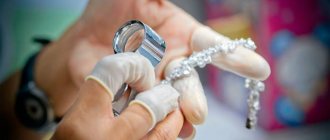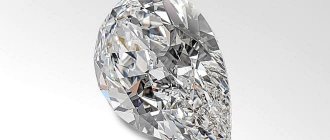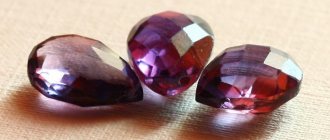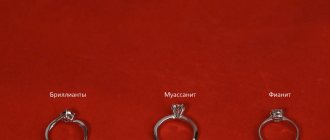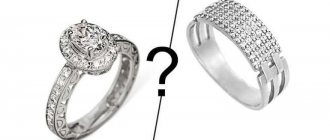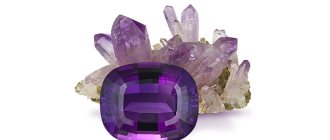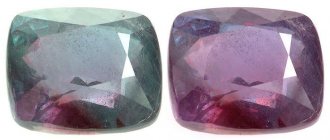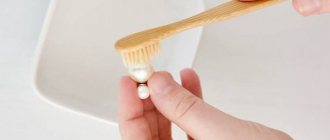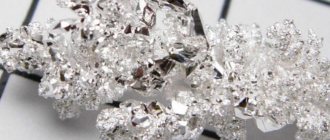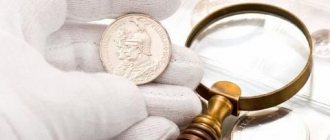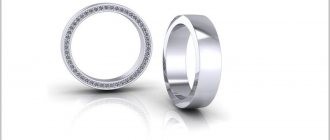Probably everyone knows what a diamond looks like. This is a very valuable stone both in cost and in its energy potential. It is beautiful, durable and capable of attracting anyone's attention only to itself. It got its name due to its bright shine, which is considered diamond. Well, if cut correctly, the stone will sparkle with all the colors of the rainbow. That is why in the old days in Rus' it was called a gem.
A little history
The exact date of its opening is not indicated anywhere. This is because when this species is unprocessed, it does not attract much attention. There are references to the fact that diamonds appeared in the third millennium BC , and they began to be used only 500 years ago, and this happened after jewelers learned how to make diamond cuts.
In Russia they were also recognized as valuable. Catherine II herself had a special love for these gems. That is why, during her reign over the country, diamonds began to be considered a sign of luxury and wealth.
Diamond got its name a long time ago due to its strength. The Arabs translate its name as “hardest,” while the Greeks translated it as “indestructible.” In ancient times, as now, the stone was highly valued and was considered a sophisticated decoration.
There are several theories about the origin of the stone. The most common is considered magmatic, that is, when the stone was formed using the crystal lattice method. And it, in turn, was formed as a result of pressure of 50,000 atmospheres directed at carbon atoms. This happened at a depth of more than 125 km, and the finished diamonds were thrown to the surface with magma.
The second theory is a result of the pressure and temperature conditions occurring after the meteorite falls.
Application
Rough diamonds of good quality and shape are always highly valued in the jewelry community. A diamond is a diamond that has been processed (or cut) by a specialist, resulting in a shape that will best reveal its brilliance and color splendor.
Small and very small stones, which are not suitable for cutting, are used to make diamond drills, which are used to process granite and other high-strength rocks. By the way, it is the famous black carbonado diamond that is most valued in the industrial sphere for the manufacture of expensive and high-quality tools. About the use of diamonds →
Mining locations
Currently, several large deposits of this mineral have been discovered. The main places of diamond mining are:
- Russia.
- Australia.
- Congo.
The percentage of production in these places is 60% of the world's stone production. A significant amount of extracted products is noted in the following countries:
- Botswana.
- Angola.
- Namibia.
And until the end of the 17th century, almost all diamond products were mined in the mines of India. At the moment this deposit is practically devastated.
There is a legend that says that diamonds were mined with the help of birds of prey. Pieces of raw meat were thrown into the crevices where minerals were located, onto which diamond placers stuck. And when the eagles flew in and grabbed the meat, people tracked down the birds and took away their prey with stones stuck to it. Or miners would look for eagle nests and take out jewelry from the droppings around them.
Main conclusions
The history of the diamond begins in India, where it was considered the personification of indestructibility and royal power. At first, the stone was not popular, because due to the lack of technology, people did not know how to process it. The first diamond cut was made in the Flemish region. The leaders in the extraction of the hardest and most shining crystals are Africa, Russia, and Brazil.
In nature, diamonds are found in yellow, red, blue, pink, green, blue and black. The most expensive gems are pure white, red and black. Stones help to improve the health of the body, protect against black magic, and promise success in all endeavors. Jewelry with diamonds is most suitable for representatives of the fire elements; it is contraindicated for water signs. The cost of a diamond depends on weight, quality of cut, color and clarity.
general description
A diamond that has already been processed is called a diamond. If we talk about what a rough diamond looks like, it is mostly transparent, but can also have subtle pink, yellow, green, gray, and sometimes even black shades. Jewelers count about 1000 varieties of diamonds.
By weight, this type of gems is divided into large, medium and small. Well, in terms of their scope of application, they can be industrial and jewelry.
In order for a diamond to radiate enormous noble power, it must be obtained freely without “the use of violence.” The best option is to receive it through inheritance: from mother to daughter or from father to son. If the mineral was purchased, its effect will not be immediate. The mineral needs to be “tamed.” But it is also possible that he will not act at all. This happens if a person is sinful or unrestrained.
Diamond is considered a symbol of courage, masculinity and innocence. Its properties include giving sharpness to hearing, protection from witchcraft, sadness and evil spirits. If someone tries to cast a spell on a person who is carrying a diamond, then all the troubles and negativity will be transferred to the organizer himself. The stone is very useful for sleepwalkers. It protects against such non-standard behavior. It is believed that even wild animals do not attack a person who carries the mineral with him.
Gems that have a greenish tint have a beneficial effect on a woman. They promote pregnancy, its normal course and ease of childbirth.
Diamond is believed to be connected to the energy field of the Sun. That is why it is used as a heart tonic. In ancient times, there was an opinion that the mineral had rejuvenating properties and also stimulated human spiritual development. You can feel the energy of a diamond when you wear it in a ring on your ring finger. But it is not recommended to wear other people’s rings with these gems.
Color spectrum
Diamonds, like many other gems, come in several shades. The standard and most expensive stones are the color “clear water”, that is, completely colorless. Such stones are extremely rare.
Next in value are three shades: white, steel and transparent. Moreover, almost always such stones will have some color tint: from yellow to cognac. An accurate assessment of the color gamut is made under a microscope in comparison with a recognized standard.
You can also find diamonds in pink, brown, red, yellow, green and even black on the jewelry market. Such diamonds are extremely rare, and their prices are prohibitive.
Photos of a diamond stone with various shades can be found on the Internet.
Main features of the gemstone
A diamond has its own characteristics that significantly distinguish it from other minerals. One of these qualities is its high density. This is what allows the stone to be used in industry. The Maos hardness scale gives the stone a score of 10. And this defines a real diamond as the hardest mineral on earth. Therefore, processing of the product takes a long and labor-intensive period. After all, the stone can withstand a lot, but leaves noticeable damage on the tool itself. It is by this property that a diamond found in nature can be identified.
The second interesting feature: when charged particles pass through themselves, current pulses and flashes appear. Therefore, even a small source of nuclear radiation causes light flashes in minerals.
Checking a diamond for authenticity in a laboratory or with a specialist
If you buy ready-made jewelry or an accessory with a diamond, it must be accompanied by a gemological certificate or product passport. This procedure is established by law in Russia; the need for examination is determined by the weight of the diamonds. Up to 1 carat, as a rule, a store tag or a certificate in the form of the selling organization is sufficient, but requesting an examination for diamonds up to a carat is the personal choice of the owner.
Stones larger than a carat undergo mandatory examination according to one of the standards. The GIA certificate is valued all over the world - having such a diamond passport in hand, no country in the world will have problems confirming the characteristics of the jewelry, and the characteristics of the stone are described in the document extremely accurately.
If you really want an accurate assessment from an expert, don't go to commercial labs. In such companies, the quality characteristics of the stones are deliberately overstated so as not to lose customers who may not like the rating that is not high enough. Independent laboratories and institutes are the best choice and the most accurate results of testing diamonds for authenticity and quality.
It just so happens in the jewelry world that certificates from Hong Kong, Israel, and Russian commercial laboratories are not trusted. While American grading standards and Russian government centers, on the contrary, have proven the validity of diamond grading.
Medicinal qualities
Diamond is valued for its energy potential. Its vibrating waves radiate only positive qualities. That is why they can solve many health problems:
- Relieve inflammatory processes and treat diseases of the skin, bronchi, bladder, gastric system and liver.
- Promote the normal functioning of the nervous system, eliminate symptoms of irritation, insomnia, and even in the treatment of schizophrenia it is possible to achieve positive changes.
- Normalize the functioning of the cardiovascular system, improving rhythm and pressure.
- Increase the chance of getting pregnant, and the passage of this stage occurs in a normal state.
There is one very unusual remedy - “diamond water”. This elixir is very easy to prepare. The mineral is placed in water for a day, and the liquid is charged with all the energy and healing properties. After this, you can use the prepared product internally. It helps to quickly recover from operations and complex illnesses.
Well, people who are impulsive and have high blood pressure are not recommended to constantly carry a diamond with them.
Rough diamonds in industry
Today, uncut diamonds are in demand not only in jewelry, where they end up after many manipulations (grinding, polishing, etc.). It is known that 85% of crystal mining goes into industrial and military production. Cutters, abrasives, and drilling devices are made from industrial diamond.
Of course, nature’s resources are not endless and the needs of industrial production and jewelry cannot be met by natural stones alone. But humanity has long found a way out: now diamonds are successfully synthesized from carbon under the influence of high temperatures and pressure. Artificial pebbles are in no way inferior to natural ones in their strength and external characteristics.
Thus, industrial diamonds have also been learned to be made without the participation of Mother Nature. Black carbonado, white board and gray ballas are their most striking representatives.
Magic properties
Diamond, of course, is very valuable, but it is also dangerous for humans if the stone is treated carelessly.
If handled roughly, he can “bear a grudge” and harm his owner. In ancient times, it was believed that the gem brought its owner strength of spirit, courage and determination. Diamond can also cure alcohol and drug addiction. It changes dissolute people for the better. Protects people from a sad state and from the evil eye, wards off witchcraft spells and softens fantasies.
It is worth knowing that the stone is predisposed to high-ranking personalities - kings, high priests or simply famous people. He will serve them faithfully. And towards ordinary people the stone shows its pride and indifference. If a gem is inherited, it can “tame” a person after about 7-10 years. He needs time to understand the essence of the owner and adapt to him. Only in this case is the active work of the mineral possible.
Historical reference
Diamond is an ancient mineral from the point of view of the first finds and mentions, and from the point of view of science, it is prehistoric. This means that people learned about diamonds as soon as they learned to find and mine various minerals. And some modern studies suggest that the age of diamond ranges from 1 to 2.5 billion years.
The discoverers of diamond, like some other precious minerals, are considered to be Indians. The treasuries of the emperors and princes of India were full of diamonds back in the days when the Persians and Greeks had just learned to smelt ore to produce iron.
However, the progress of the Indians ended there, because they did not know how to process the solid mineral. The diamond has become a symbol of strength, resilience, and indestructibility of rulers. But the unprepossessing appearance of the natural stone prevented the nugget from being assessed as a jewel.
How to spot a fake
The most common way scammers deceive people is by replacing precious stones with cheaper and similar materials. To replace a diamond, use transparent zircon, colorless sapphire or regular crystal. To distinguish a fake from a real stone, you need to point the product at the sun. Diamond transmits the sun's rays through itself so that only a point remains in reflection. A fake will let all the sunlight pass through itself.
There is another trick to identify a diamond in nature. In modern times, diamonds are created in laboratory conditions. Such a stone cannot be distinguished from natural stone by appearance. You just need to pay attention to the cost. It cannot be that a diamond is sold for next to nothing.
At one time, the French chemist Margot proposed the following method of verification: to distinguish a fake from a real mineral, you need to draw a line along the surface with an aluminum stick. Such manipulation will leave a clearly visible silver-colored mark on a fake product, which is very difficult to erase, but there will be no traces on the diamond.
Only a professional appraiser can give a 100% guarantee that the person is looking at the original.
What can it be easily confused with?
The colorless transparency of most diamonds makes them visually indistinguishable from glass and other stones:
- rock crystal;
- colorless topaz;
- white zirconium;
- leucosapphire;
- quartz.
Synthetic materials such as moissanite, cubic zirconia, and rutic do not create problems - they are distinguished from diamond gems by their cut and brilliance.
Artificial diamond has other qualities (for example, low transparency). Used in technology and industry.
Amulets and talismans
Diamond amulets give the owner protection from all negative influences from other people. Well, talismans bring success and good luck.
For good luck in business, a diamond must be combined with the “metal of fire” - gold. Therefore, it is recommended to use this combination in the form of rings and wear them on your left hand. Success in the game will be brought by a talisman in the form of a ring with a diamond, worn on the middle finger of the hand. A man will bring sexual energy if he wears an amulet on his little finger. This option allows you to find new partners without much difficulty.
Women also benefit greatly from wearing diamonds. Earrings and necklaces should include not the single existence of a diamond, but its scattering. This inclusion of stones eliminates masculine character traits in a woman and gives her the energy of charm, love and happiness. If diamond products have defects, then instead of benefit, you can get harm. Therefore, it is necessary to carefully select diamonds for amulets and talismans.
Weight is everything
But how to determine the price of unprocessed? Or it is worthless and cheap, because it lacks shine and a smooth surface with many edges. But no! And an uncut diamond has its value. Of course, young ladies are unlikely to dream of receiving such a nugget, but true connoisseurs of natural beauty and collectors will consider it lucky to find or at least hold in their hands a natural stone carved in the depths of a volcano.
By the way, its price will depend on the degree of transparency, color and, of course, weight. As you know, it is measured in carats. 1 carat is equal to 200 mg. The larger the stone, the more expensive it is.
Thus, in the summer of 2016, the Lesedi la Rona diamond was sold at auction in the United States. This is the largest specimen mined over the last century, weighing 9.5 carats. According to experts, the age of the mineral is about 3 billion years. The seller hoped to auction it for no less than $86 million, but only $61 million was offered for the lot. The auction did not take place.
Man-made jewel - artificial diamond
An artificial diamond has become a full-fledged substitute for a gemstone obtained from a natural diamond. It is grown in laboratory conditions and has physical and chemical properties characteristic of natural diamonds.
It is important not to confuse a grown diamond with an imitation diamond. The latter include rhinestones, moissanites and cubic zirconia. These stones, like diamonds, are found in a variety of jewelry, but the cost of copies is much lower than the price of the original.
What is an artificial diamond
Such stones are obtained from diamonds grown in specially created conditions. Artificial stones are obtained from crystallized pure carbon. They have a chemical composition, thermal water, and transparency similar to natural minerals.
Visually, a synthesized diamond cannot be distinguished from a natural one. Typically, the weight of an artificial diamond does not exceed 1 carat. Growing larger specimens is considered unprofitable.
The reason for the development of synthetic diamond technology is that high-quality diamonds are very rare in nature. If only natural gems were used in the jewelry industry, the cost of finished jewelry would be unaffordable. Also, the amount of raw materials extracted from nature would not be able to satisfy the demand of the jewelry industry.
Where are they in demand?
Almost 90% of the total volume of stones produced in laboratory conditions is used by machine-building enterprises. Also, the demand for diamonds is generated by industries that practice nanotechnology.
Analogs of natural gemstones are widely used in the manufacture of silver and gold jewelry. Rings, earrings, pendants, bracelets, pendants, and brooches are encrusted with shining stones. They are also used as decorative elements on branded clothing, shoes, and accessories.
Artificial Diamond Colors
Colorless diamond is very rare in nature. The stones are characterized by polychromatism. This means that they come in a variety of shades. The variety of colors is due to the presence of impurities of other chemical elements in the composition of minerals. Fancy colored diamonds are produced from multi-colored diamonds.
Interesting! Today, the technology for producing colored diamonds in laboratory conditions is used. A specific amount of other chemical elements is added to carbon, giving the mineral a specific color.
- Blue - the shade varies from pale blue to blue. The color range is obtained by adding boron. Maximum weight – 1.25 carats.
- White is the most popular. Its cultivation is considered technologically complex and labor-intensive. Specialists involved in the synthesis of colorless diamonds carefully analyze the chemical composition, preventing the appearance of foreign elements in it. Maximum weight – 1 carat.
- Yellow – there are pale yellow, lemon and orange specimens. Such shades are due to the presence of nitrogen in the composition. The technology for producing yellow diamonds is considered the simplest and fastest - the stones grow after 4 days.
- Other colors - red, pink, green and purple - are the result of mixing different chemical elements included in the raw material.
Artificial diamond and imitation are different things
Artificial diamond gems are mistakenly considered imitations. Replicas are stones that look like real diamonds due to their brilliance and shine. However, the chemical composition and physical properties of such gems do not coincide with the characteristics of diamonds.
? ? ? FIVE MYTHS ABOUT DIAMONDS⠀⠀Friends, Ekaterina and the Amulet from Funny Cat are with you! I really love beautiful stones, including...
Moissanite
This is the most expensive copy of a diamond. It is also called the space stone. In terms of its chemical formula, it is silicon carbide. The properties of the stone were first studied by Henry Moissan, who was awarded the Nobel Prize for his discovery.
The shine of moissanite is more pronounced than that of a diamond. The stone is also characterized by bright reflections. The gem is used in the jewelry industry. Only an experienced gemologist can distinguish moissanite from a diamond.
cubic zirconia
Zirconium dioxide with cubic system is called cubic zirconia. In jewelry it is placed in a silver or gold frame. Rings, bracelets, pendants and other jewelry are encrusted with gemstones. Cubic zirconia is used in optics - magnifying glasses and lenses are made from them. Disadvantages include low hardness, which makes the stone susceptible to mechanical damage.
Nexus
Formed when carbon combines with other chemical elements. It has a high level of hardness, which is also typical for a genuine diamond.
Rhinestones
The discoverer of shiny stones was Georg Strass. The first rhinestones were produced by a jeweler by using metal powder as a substrate for glass. Today, stones are made from crystal combined with a small amount of lead. Colorless rhinestones are considered the most popular.
They are used in making jewelry. Rhinestones are used to decorate shoes, clothes, underwear, decorative items, and souvenirs. To obtain colored stones, other chemical elements are added to the base composition. Thus, chromium oxide is contained in imitations of emeralds, iron oxide – in imitations of topaz.
